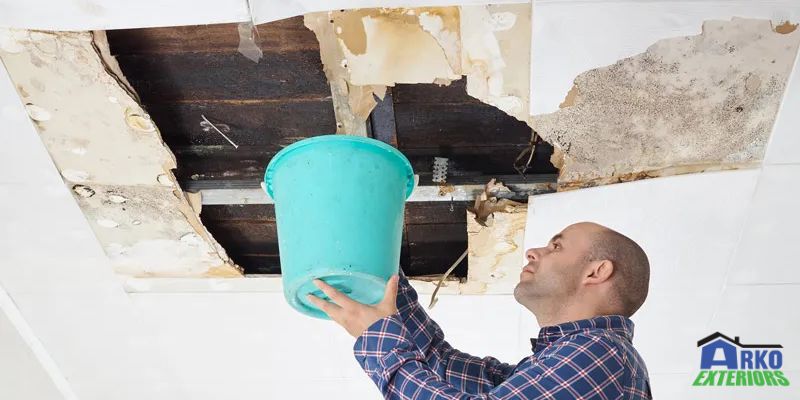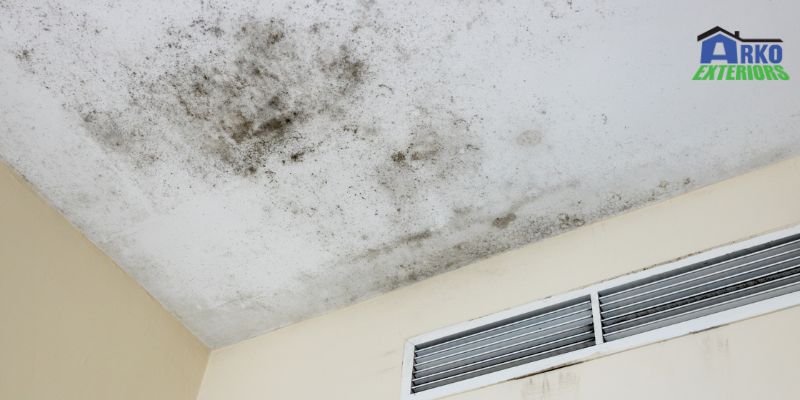A well-maintained roof is essential for protecting your home from the elements. Unfortunately, roof leaks can occur, allowing water to penetrate into the structure. Moisture intrusion, if left unaddressed, can lead to a variety of issues, including the growth of mold.
What are some of the dangers of moisture intrusion? Here are some…
#1 Structural Damage

One of the primary risks associated with roof leaks and moisture intrusion is structural damage to your home. When water seeps through the roof, it can penetrate into the walls, ceilings and other structural components. Over time, this moisture weakens the structural integrity, leading to rot, deterioration of building materials and compromised stability. Repairing such damage can be costly and may involve replacing damaged materials, reinforcing weakened structures and addressing any underlying issues.
#2 Mold Growth

Moisture intrusion provides an ideal environment for mold growth. Mold spores are naturally present in the air, and when they encounter moisture, they can quickly multiply and colonize. Mold can grow on various surfaces, including drywall, insulation, wood and fabrics. When mold proliferates, it releases spores into the air, which can be inhaled and pose health risks to occupants.
#3 Health Risks
Exposure to mold can lead to a range of health issues, particularly for individuals with allergies, respiratory conditions or weakened immune systems. Mold spores can trigger allergic reactions, including sneezing, coughing, watery eyes and skin irritation. Prolonged exposure or exposure to high levels of mold can cause more severe health problems, such as respiratory infections, asthma exacerbation and even systemic infections in rare cases.
#4 Indoor Air Quality
Moisture intrusion and mold growth can significantly impact indoor air quality. Mold spore particles can be inhaled and deposited in the respiratory system. Poor indoor air quality can lead to discomfort, respiratory symptoms and exacerbation of existing health conditions. It is particularly concerning for individuals spending a significant amount of time indoors, such as children, the elderly or those with compromised immune systems.
#5 Property Value
Neglecting roof leaks and allowing moisture intrusion and mold growth to persist can also have an impact on the value of your property. Mold issues are a significant concern for homebuyers, and a property with a history of mold or water damage may be less attractive on the market. Additionally, extensive damage caused by moisture intrusion can reduce the overall value of the property, requiring costly repairs and remediation efforts to restore its condition.
#6 Electrical Hazards
When water infiltrates your home through roof leaks, it can come into contact with electrical wiring or fixtures. This poses a significant electrical hazard, as water is a conductor of electricity. If water enters light fixtures, outlets or electrical panels, it can lead to short circuits, power outages and even electrical fires. To ensure the safety of your home and its occupants, it is crucial to address roof leaks promptly and avoid any potential electrical hazards.
#7 Pest Infestation
Moisture intrusion attracts pests such as termites, ants and cockroaches. These pests are drawn to damp environments and can find their way into your home through roof leaks. Once inside, they can cause further damage to the structure and compromise the integrity of your property. Additionally, pests can carry diseases and allergens, posing health risks to occupants. By addressing roof leaks and reducing moisture levels, you can help prevent pest infestations and maintain a healthier living environment.
#8 Increased Utility Bills
Roof leaks and moisture intrusion can also lead to increased utility bills. When water enters your home, it can affect the insulation in your walls and attic, reducing its effectiveness. As a result, your heating and cooling systems must work harder to maintain the desired temperature, leading to higher energy consumption and increased utility costs. By promptly addressing roof leaks and moisture issues, you can help maintain energy efficiency and keep your utility bills in check.
#9 Decreased Lifespan Of Roofing Materials
Roof leaks and moisture intrusion can significantly shorten the lifespan of your roofing materials. Constant exposure to water can cause shingles to deteriorate, lose their protective granules and become weak and brittle. In turn, this can lead to more frequent roof repairs or the need for a complete roof replacement sooner than anticipated. By promptly repairing roof leaks and addressing moisture issues, you can help extend the lifespan of your roofing system and avoid the additional expenses associated with premature roof replacement.
#10 Impact On Allergies & Respiratory Conditions
For individuals with allergies or respiratory conditions, moisture intrusion and mold growth can have a significant impact on their health. Mold spores can trigger allergic reactions and asthma symptoms, leading to respiratory distress, coughing, wheezing and difficulty breathing. If you or your family members have existing respiratory conditions, it is crucial to address roof leaks promptly and take measures to prevent mold growth to maintain a healthy living environment.
Summary:
Roof leaks and moisture intrusion pose significant risks to both the structural integrity of your home and the health of its occupants. Promptly addressing roof leaks and taking appropriate measures to mitigate moisture intrusion is crucial to prevent further damage and mold growth. If you notice signs of roof leaks, such as water stains, peeling paint or musty odors, it is essential to consult with roofing professionals and address the issue(s) promptly. By doing so, you can protect the value of your property, ensure a healthy living environment, and mitigate the risks associated with mold growth and poor indoor air quality.

